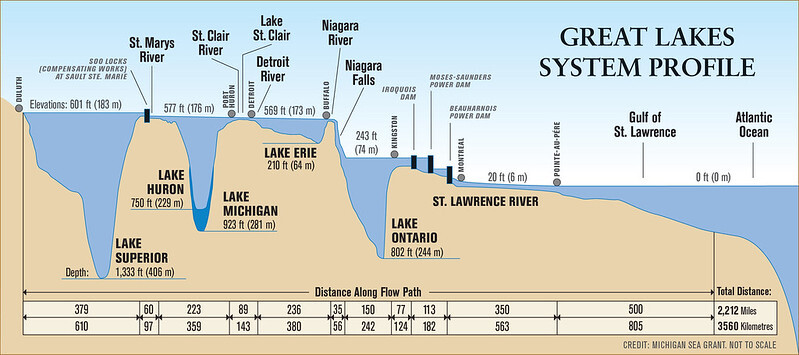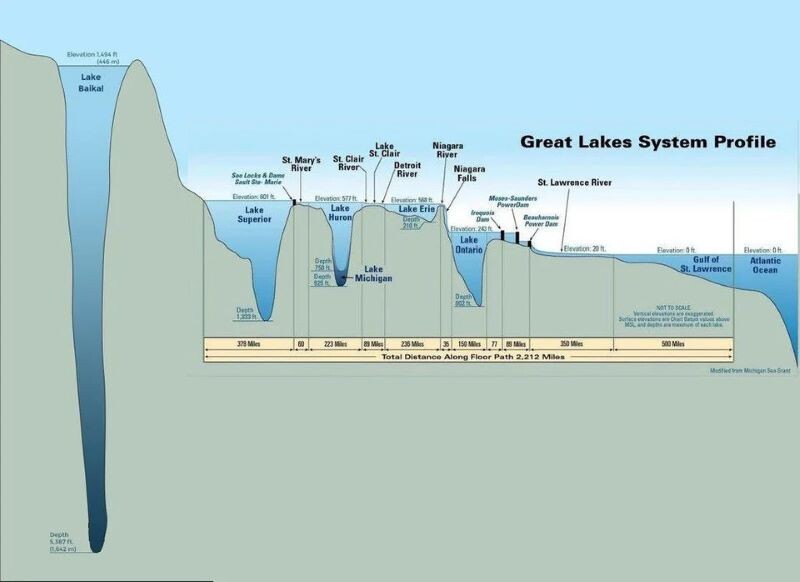Image


Our Great Lakes are an expansive freshwater system that stands as a shining example of nature’s power and majesty. But it may surprise you to learn our Great Lakes have a Siberian rival.
Stretching across a significant portion of North America, the Great Lakes are not just massive reservoirs of water but also repositories of fascinating facts and tales.
The origins of the lakes' names provide a glimpse into the rich history and diverse cultures that once thrived here. The names are rooted in Native American languages and French. For instance, Lake Superior is derived from the French term "lac supérieur," translating to "upper lake." Similarly, the name Michigan comes from the Ojibwa word "mishigami," denoting "great water." Lake Huron pays homage to the Huron indigenous people. Erie is named after the Erie Tribe, signifying "long tail." Ontario's name originates from the Iroquoian language, meaning "beautiful lake."
 The Great Lakes System Profile by Michigan Sea Grant.
The Great Lakes System Profile by Michigan Sea Grant.As the nations before us knew, and science now confirms, the Great Lakes are awe inspiring. The Great Lakes collectively hold approximately 84% of North America's freshwater, a staggering 20% of the world's freshwater. Lake Superior, the most profound of them all, boasts an average depth of 500 feet, plunging to its deepest at 1,333 feet. The combined shoreline of these lakes extends for an impressive 10,000 miles, almost half the Earth's circumference.
These lakes also narrate stories of the past, with an estimated 6,000 shipwrecks resting in their depths, many impeccably preserved due to the cold freshwater. However, this vast water body is not just about serenity; it significantly influences regional weather. During winters, the phenomenon known as "lake-effect snow" occurs, with cold air sweeping over warmer lake waters, resulting in heavy snowfall in areas downwind. Just ask folks living on the west coast of Michigan or the eastern end of Lake Erie in Buffalo, NY.
Among the numerous islands dotting these lakes, Manitoulin Island in Lake Huron stands out as the world's largest freshwater island. Surprisingly, Lake Superior alone can cover both the American continents with water up to a foot deep.
The ecological balance of the Great Lakes is delicate, challenged by over 180 invasive and non-native species like the zebra mussels and lampreys. These accidental and deliberate invaders pose threats to native species and ecosystems.
Formed by glaciers during the last ice age, the Great Lakes are interconnected by rivers and channels, eventually draining into the St. Lawrence River. A hub of biodiversity, they house over 3,500 unique species of flora and fauna. Beyond their ecological significance, they are an economic powerhouse for the United States and Canada, supporting industries like shipping, manufacturing, and tourism. Moreover, they quench the thirst of millions, supplying drinking water to vast populations.
Despite their magnificence, there's another freshwater titan worth mentioning: Lake Baikal in Siberia, Russia, one of the most unique and intriguing lakes in the world. When you compare it to the combined Great Lakes system of North America, several distinct characteristics and features arise. Here's a comparison:
 Reddit user u/AristonD posted an edited version of the Great Lakes System Profile created by Michigan Sea Grant showing the interesting visual comparing the Great Lakes to Lake Baikal in Siberia.
Reddit user u/AristonD posted an edited version of the Great Lakes System Profile created by Michigan Sea Grant showing the interesting visual comparing the Great Lakes to Lake Baikal in Siberia.Age:
Volume:
Depth:
Biodiversity:
Size and Surface Area:
Cultural and Economic Importance:
Threats:
Both Lake Baikal and the Great Lakes are colossal reminders of nature's ability to create, sustain, and inspire. They're not just waterscapes. They're landscapes of history, culture, and ecological wonders. As we marvel at these natural giants, we're reminded that water is the lifeblood of our planet, and these lakes stand as profound symbols of nature's enduring majesty and might.
Sources: